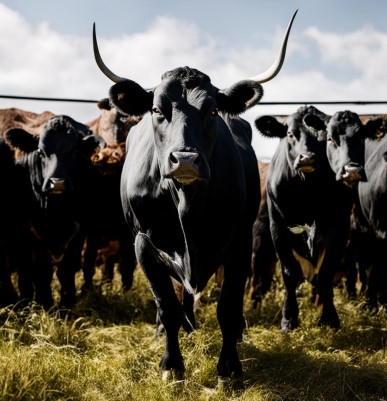Bursitis in cattle

Bursitis is a disease of the musculoskeletal system of cattle , accompanied by inflammation of the synovial bursa. The capsule, located in places where the joints experience the greatest load, performs a protective function. The bursa is filled with fluid that reduces joint friction.
Pathogenesis and causes
The disease most often occurs due to internal or external trauma to the joints, severe hypothermia, and mechanical stress.
The main causes of bovine bursitis:
- infection that has penetrated the membrane of the bag;
- uncomfortable hard-surface stalls and feeders;
- keeping on a short leash;
- high crowding in the barn;
- frequent transport services.
The prerequisites for bursitis appear when the rules for keeping cattle are not followed, lack of regular care, or poor diet. The risk increases when cattle are kept in buildings with cold concrete floors. Inflammation of the synovial bursa can also occur against the background of various infectious diseases.
Flow forms
Based on changes in tissues and the structure of exudate, bursitis is divided into two types: purulent and aseptic. The first is accompanied by the formation of a painful swelling. The skin in the area of inflammation is hot, the animal develops lameness, and general HEALTH worsens. The second occurs with severe swelling, redness of the pathological area, and infiltration.
Types of aseptic bursitis:
- Serous - exudate consists of plasma and blood particles.
- Serous-fibrinous - the fluid contains the blood plasma protein fibrin.
- Fibrous - the contents of the bursa include large particles of fibrin containing epithelial cells.
- Ossifying - the pathological cavity is filled with fibrous tissue.
Symptoms
In the acute form of bursitis in cattle, the following signs appear:
- swelling;
- limited movement;
- round swelling in the area of the knee joint;
- redness and increased temperature in the affected area.
When it becomes chronic, a dense, mobile neoplasm appears in the area of the hock joint. The skin in this area thickens.
Treatment
NITA-FARM preparations have shown good effectiveness in the treatment of bursitis:
- "Nitox Forte" is a super-long-acting, long-acting oxytetracycline enhanced with an NSAID. Used in a dose of 1 ml per 10 kg of cattle weight once. Valid for 5 days.
- "Nitox 200" is a drug based on oxytetracycline with a prolonged action. The course of treatment consists of just one injection. The therapeutic level of the antibacterial drug in the body lasts up to 72 hours.
- Lexoflon is a drug with a wide spectrum of antimicrobial activity. It is administered intramuscularly at a dosage of 1 ml per 30 kg of body weight. Duration of treatment is 3–5 days.
- A course of administration of the drug Flunex or Ketoprofen 10% is indicated as an anti-inflammatory agent.
If bursitis is not treated promptly, soft tissue damage may occur.
Prevention
To prevent the development of bursitis, a dairy cow should rest for 12–14 hours. Cattle should have comfortable bedding made of sawdust, hay, straw or special rubber mats.
Read together with it:
- США: Обзор рынка КРС за 48 неделю от 01 декабря 2025 годаМинистерство сельского хозяйства США (USDA) сообщило о снижении оптовых цен на говядину, при этом спред между ценами на мясо категорий Chioce и Select увеличился до 15,77 доллара. Цены на говядину Choice снизились на 1,46 доллара до 366,82 доллара, а на говядину Select — на 4,46 доллара до 351,05 доллара. Общий убой крупного рогатого скота, подтвержденный федеральной проверкой Министерства сельско...
- Import substitution, jobs. A feed mill has been reconstructed in the Vitebsk region.November 28,Vitebsk . Vitebsk Broiler Poultry Farm OJSC has opened a new import-substituting production facility in the Vitebsk District, the Vitebsk Regional Executive Committee told BelTA. Vitebsk Broiler Poultry Farm OJSC has completed a project to reconstruct its feed mill. Construction began in February 2......
- Производство мяса и молока в Алтайском крае увеличилось, несмотря на снижение поголовья скотаТем не менее, ключевые показатели производства показывают позитивную динамику. В период с января по октябрь 2025 года в хозяйствах всех категорий было произведено 196,4 тысячи тонн скота и птицы на убой, 887,1 тысячи тонн молока и 975,2 миллиона яиц. Значительный рост отмечается в сельскохозяйственных организациях: производство мяса увеличилось на 5,4% (до 144,9 тысячи тонн), молока — на 3,4% (до ...
- Специалисты КСУП "Нива-Барсуки" рассказали, как удалось собрать самый большой в своей истории урожай зерновыхНовости темы Одно из передовых сельхозпредприятий Могилевской области КСУП "Нива-Барсуки" в этом году собрало самый большой в своей истории урожай зерновых. Как итог, в четвертый раз подряд сельхозорганизации вручили почетное переходящее знамя Кировского райисполкома. Кроме того, хозяйство входит в тройку лидеров среди аграриев Могилевщины в номинации "Экономическая эффективность". Пообщались со с...
- Удмуртия получит 24,7 млн рублей на геномные исследования в скотоводствеЭти средства будут использованы для исследования 9 тысяч голов молодняка крупного рогатого скота с целью выявления генетических аномалий и генов, способствующих высокой продуктивности. Данное решение было принято 24 ноября федеральной трехсторонней комиссией по распределению бюджетных средств, как сообщил депутат Госдумы от Удмуртии Андрей Исаев.......


